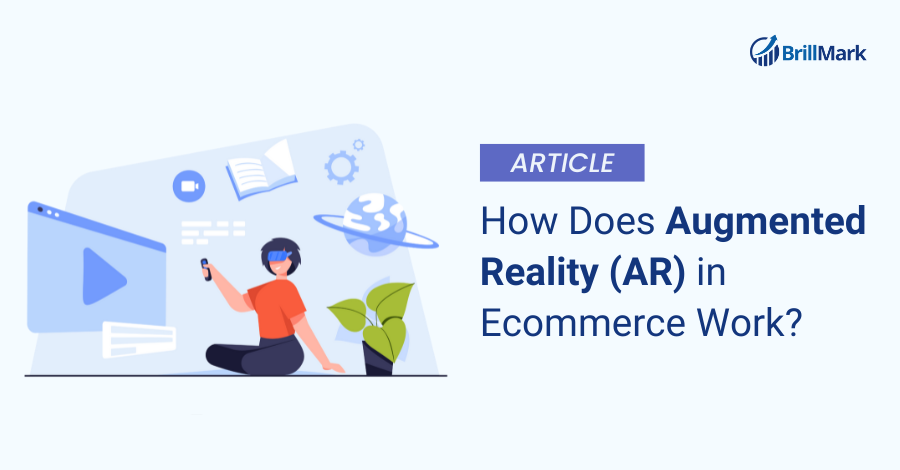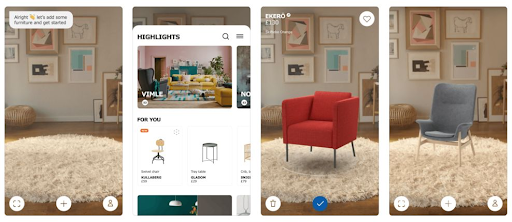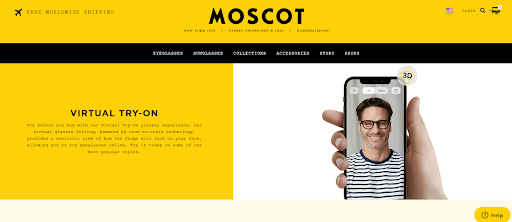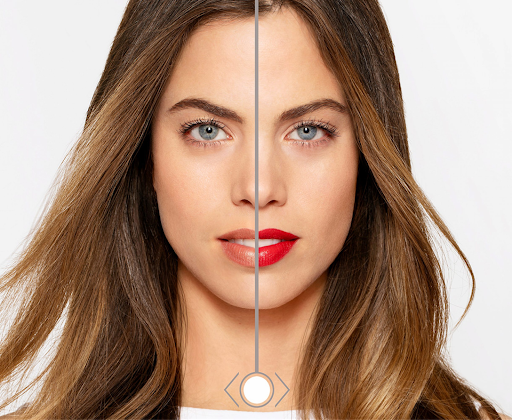According to Statista, the augmented reality market is valued at $30.7 billion, with around 810 million active mobile users.
Like many of us, your home may have a few projects in motion.
Let’s say you want to buy a piece of furniture online for your house, but you are unsure whether that particular color will look good.
The shop owner is one step ahead.
They understand your problem and offer a solution. You can see how the product looks virtually in your space, giving you a better idea of whether this is the right fit.
With a virtual representation of the product, you can visualize how it would look in your house without spending any money.
This visual representation is what we call AR or Augmented Reality.
In a brick-and-mortar store, you can try on clothing, touch textiles, and gauge the size of a couch.
One of the most significant difficulties of internet purchasing is that it does not facilitate a complete sensory product experience.
Those things are technically impossible in ecommerce, but augmented reality (AR) applications allow you to provide customers with more profound and comprehensive product information from the comfort of their homes.
Brillmark believes that if there is a method or way to make the customer shopping experience the best, we should analyze and implement it in the online store.
Augmented reality, or AR, is one such thing that plays a significant role in enhancing the customer journey and, from what we know, will increase conversion rates in the near future.
What is the meaning of Augmented Reality in E-commerce?
Global AR advertising revenue, which topped at half a billion in 2019, grew to $1.41 billion in 2020.
Augmented reality in e-commerce enables shoppers to try on and test things using just a mobile device.
AR creates the illusion that shoppers are in a physical store engaging with items.
The retail industry has several prospects for augmented reality, particularly in ecommerce.
Despite the level of experience people have with ecommerce, there are still certain transactions that buyers feel they need additional information in order to commit.
This might hinder the online sale of specific product categories.
How Ecommerce Companies Employ Augmented Reality
Snap Inc. reports that more than 100 million consumers are shopping with AR online and in stores.
AR allows ecommerce shoppers to sample items or experience services in their surroundings and at their own pace before making a purchase decision.
Using augmented reality, your consumers may preview items and are more likely to make a first-time purchase.
Here is how companies employ AR:
Virtual fitting solutions
“It seemed fantastic on the store mannequin.” This is the general thought of everyone, at least once, before trying on the clothing for the first time and figuring out it does not fit.
The very thought of this exact consequence can limit conversion rates.
Consumers want to know precisely what they are purchasing and take every effort to ensure they receive exactly what they desire.
And if they decide to purchase and it does not work out, your return rates will increase.
AR assists online buyers in understanding what they are purchasing and how the products will function without entering a store.
There are comparable apps for apparel, cosmetics, accessories, and eyewear.
Preview placement.
What will the couch’s actual appearance be in your living room?
How large will the television look on the wall?
It can be difficult to determine even while examining the actual item at a store, much less when seen on a small computer or smartphone screen.
Preview placement gives buyers a real-time preview of how a product will appear in their familiar setting.
Manuals for interactive user interfaces
If you offer a product with a learning curve, an interactive user manual is a wonderful augmented reality (AR) application to assist consumers in better understanding how your product functions.
When utilizing software, a website, or an application, an interactive user manual reacts to the user’s activities and provides contextual guidance on the page.
Numerous augmented reality (AR) user manual applications scan the product and identify the buttons in the real-world surroundings, utilizing graphical arrows and text-based animations.
According to Google’s AR Survey for 2019, 66% of individuals are interested in utilizing AR to assist with shopping choices.
Social media filters.
A recent Instagram Stories or Snapchat user may have utilized an augmented reality (AR) filter.
Once utilized solely for entertainment, the number of businesses utilizing augmented reality (AR) social media filters has steadily increased.
Here are a few advantages:
- It is a terrific approach to display a new product by allowing customers to try it and see how it fits.
- The novelty of AR filters can increase audience engagement and motivate individuals to tag you in their content.
- The “wow” factor may help you stand out among companies on social media by highlighting what makes you unique.
Augmented Reality Can Help Your Retail Store Grow
According to UPS research, 27% of buyers returned something because it was “not as described.”
The challenge of expressing actual, three-dimensional goods in a virtual, two-dimensional environment is one of the main difficulties of ecommerce.
AR can help bridge the gap between in-store and online buying by making it easier to depict items and providing consumers with a better grasp of what they purchase.
Here are some of the tasks that AR may assist you with:
Increase consumer participation.
AR is naturally interactive, making it simple to captivate users on your website.
The longer they remain on your ecommerce site, the greater their likelihood of making a purchase!
Even if customers do not purchase during their visit, the increased involvement with your brand and product indicates that they have formed a relationship with you and are more likely to remember you in the future.
Increased shopping duration and conversion rate gains
Currently, video is considered indispensable in ecommerce.
Customers spend more time on a website and have a higher conversion rate if instructional films assist them in better comprehending a product.
According to research by Vertebrae, a business specializing in augmented reality and three-dimensional ecommerce, conversion rates for clients who utilize augmented reality will increase by 90% by 2020.
We can quote robust research demonstrating that AR has a comparable effect in two years.
On certain Shopify product pages, augmented reality 3D models have raised conversion rates by as much as 250%.
Acquire new consumers.
You must generate a buzz in a loud environment to attract people’s attention.
Creating an engaging AR campaign is one method to achieve this goal.
Enhancing customer relations
The augmented reality’s immersive experience allows ecommerce firms to interact with new consumers and establish a long-lasting and trustworthy relationship with them.
Augmented reality technology increases customer interaction with ecommerce firms, which can eventually lead to higher conversion rates.
According to research by Facebook’s AR partner Vertebrae, shops that utilized AR technology during the Covid-19 outbreak saw a 19% boost in customer interaction.
Moreover, client conversion rates improve by 90% for consumers that utilize augmented reality compared to those who do not.
Reduce returns.
You can provide clients with more product information than a static image or video with AR.
In addition to providing 3D views, you may display how a product would seem in a consumer’s area, reducing the likelihood of receiving a product that does not match their expectations.
Launch new products on social media using AR filters
AR technology is an excellent approach to amuse clients and generate brand buzz.
Create a highly engaging augmented reality (AR) campaign to help you reach more consumers.
AR technology on social media filters such as Instagram and Snapchat is the most effective approach to launching new products to the audience.
Companies like Netflix, Gucci, H&M, Adidas, and Lego actively release new products using Instagram AR filters.
60% of Instagram users will likely find new items using the platform.
How to Implement Augmented Reality in Online Store.
If you’ve decided to implement augmented reality in your organization, here are some measures to follow.
Clarify your organization’s aims.
What do you wish to accomplish?
And how does it benefit your clients?
Make sure you don’t stop after answering the first question since the second question can transform an excellent AR application into a terrific one.
You must know precisely what you want the client experience to accomplish.
Determine your vision and objectives before diving into the technical components of your augmented reality application.
Once you know your destination, selecting the necessary approaches and technology will be easy.
Identify the augmented reality tools you wish to employ.
Once you have determined what you wish to produce, you can begin selecting the necessary instruments.
Here are the considerations you must make:
- You may use an augmented reality platform with a free license if you have a restricted budget.Numerous augmented reality technologies provide both free and paid licenses. However, the free version will be less robust than the paid program.
- Whether you intend to run your augmented reality application on mobile devices, computers, or AR glasses, ensure that the tool you choose is compatible with the app’s hardware.
- If you intend to build apps for many operating systems, ensure that the platform you select supports all of the operating systems you intend to launch.
- Carefully assess each platform’s capabilities to discover if it possesses the specific features you want. For instance, not all platforms enable geo-location.Thus, these will not be useful if you want to construct a location-based augmented reality (AR) application.
Promote your new product.
After putting in so much effort to create your product, you will want to ensure everyone knows it exists!
Here are some methods to spread the word:
- Create a demo video: Create promotional and instructional movies that illustrate how to use your application.
- Show app-internal instructions: Provide clear instructions so that users understand how to get the most out of your application.
- Create material that can be shared: Permit users to share their augmented reality experience with their peers and social media contacts.
Example of Ecommerce Brands that use AR
IKEA
The IKEA AssembleAR app employs augmented reality to aid customers in unwrapping and assembling IKEA items. This application is designed with Apple’s ARKit augmented reality (AR) technology.
MOSCOT
MOSCOT collaborated with Vertebrae to add features for virtual try-on.
Customers may inspect the designs from all angles using the 3D model, then see the glasses mapped on their faces using AR technology that considers their facial traits.
L’oreal
L’Oreal is a well-known participant in the beauty market, but the company is also a leader in Beauty Technology.
L’Oréal has undergone a digital transition over the past decade, with the goal of becoming the leading Beauty Tech firm by giving customers an “unmatched experience in terms of enhanced goods and services.”
In 2018, L’Oréal purchased AR try-on technology firm ModiFace.
L’Oreal says that ModiFace is a “strong driver of online sales acceleration,” with conversion rates tripling when ModiFace is accessible and more than a billion visits, and an average of seven minutes spent on its services.
DFS
DFS is the largest sofa retailer in the UK, with over 120 stores.
With astounding results, they implemented the world’s largest web-based augmented reality installation in January 2020.
Using 3D and augmented reality-assisted visualizations, DFS enabled buyers to virtually show over 10,000 couches in their homes.
Despite closing stores due to Covid-19 limitations, DFS has achieved remarkable conversion and sales achievements since using augmented reality.
DFS revealed in December 2020 a 112% increase in conversions and a 106% increase in revenue per visit for consumers who interact with 3D and AR vs. those who have not.
Conclusion
The value of augmented reality is already in the billions and will continue rising rapidly in the next few years.
By 2024, its value will approach $300 billion. As a result, the accuracy and utility of the technology will only continue to advance.
AR is a valuable option for clients to try before purchasing online. It is practical and dynamic and gives the client a unique buying experience.
Augmented reality is unquestionably on the verge of revolutionizing the entire industry and will become necessary for all major firms that wish to remain competitive in this rapidly expanding sector.
You will get more conversions for your brand if you execute it well.
Although it may sound inconceivable, the future has arrived.
AR, VR, and 3D have already demonstrated several practical advantages for ecommerce retailers willing to take the (little) jump.
We hope this article has helped you understand why AR is necessary for boosting Conversion Rates.
Always keep in mind that your ultimate success depends significantly on customer satisfaction.
Consider what customers have said and how you can use their input to enhance their experience and conversion rates before implementing any changes.
A/B testing is an established method for boosting the conversion rate of product pages.
It helps you avoid making inevitable elementary mistakes that, if overlooked, might have significant consequences for your business.
The results of A/B testing improve the site and, as a result, the user experience.
The first step is to create a clear strategy for the undertaking while allowing flexibility.
Dynamic A/B testing requires the help of skilled engineers, UX designers, Q/A specialists, and others; thus, it is recommended to outsource the A/B tests.
Contact Brillmark if you need assistance with A/B testing, building, or setup. With the assistance of our expertise, your team may accomplish new feats.
Contact us whenever you are ready if you are interested in learning more.














